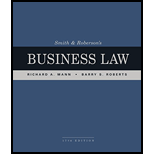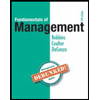
To explain: Types of contracts that might violate a statute and distinguish two types of licensing statutes.
Explanation of Solution
Licensing statute: A statute requiring a person or business to obtain a government license before they engage in a specified occupation or activity.
- Regulatory license: It is a mechanism designed to protect the public against unqualified individuals, ordinarily a person cannot qualify for professional services unless he has the requisite regulatory license.
- Revenue license: In comparison, a revenue license is given to raise money, deals are enforceable for unlicensed services.
Gambling statutes: Contracts found violating a gambling statute are void. Insurance policies do not come under gambling laws except where the person taking the policy has no insurable interest in insuring the property or the individual. Given the element of chance involved in deciding the future price, so-called futures contracts are not considered gambling.
Usury statutes: Laws establishing a maximum allowable interest rate for which a lender and money borrower may contract. A lender who violates a usury statute can forfeit both the principal and interest, only the interest, or the interest that exceeds the limit allowed. In some jurisdictions the amount forfeited is a multiple of the interest charged.
Sunday statutes: Common law does not prohibit concluding Sunday contracts. Some states have legislation, blue laws, which amend this common law rule and on Sunday prohibits certain types of commercial activity. Blue laws do not usually extend to “need” and “charity” activities.
Want to see more full solutions like this?
Chapter 13 Solutions
Smith and Roberson’s Business Law
- This was the question asked of Jack Otto, production supervisor, by one of his manufacturing workers, Clyde Fisher. Jack had been wondering the same thing for several weeks about Bob Hill, another of his welders. Jack Otto is a 54-year-old production supervisor who has been with Store Fixture Manufacturing Co. (SFM) for 20 years. He is well liked and respected by his peers and subordinates and is very competent at the technical aspects of his supervisory job. Bob Hill, 40 years old, has been a generally competent and productive welder at SFM for ten years. Bob has been popular with his coworkers. Although he periodically "blows up" at them, he always apologizes afterward. His absenteeism rate has been higher than average for the last several years, with most absenteeism on Mondays. Also, it is not uncommon for Bob to be 10–15 minutes late at least once a week. But, because of a shortage of experienced welders and because Bob often cuts his lunch hour short to make up his tardiness…arrow_forwardSince the mid-1950s the proportion of American workers represented by unions has: A. Decreased. B. Grown only in the manufacturing sector. C. Remained about the same. D. Increased.arrow_forwardThe Occupational Safety and Health Act gives workers the right to a job: A. With wages that enable an employee to enjoy a decent standard of living. B. That does not require them to lift, bend, or move items at any time on the job. C. That is free from recognized hazards that are likely to cause death or serious injury. D. With equal wages for similar kinds of work.arrow_forward
- The right to a safe and healthy workplace is accurately described by which statement? A. Extensive training and careful precautions are necessary to avoid accidents, injuries, and illness. B. Regulations and enforcement have failed to curb worker accidents. C. Over recent years no new categories of accidents or illnesses have emerged. D. A very limited number of jobs are potentially hazardous to workers’ safety and health.arrow_forwardThe employment relationship: A. Indicate that employees are dependent on their employers for their livelihoods. B. Implies that employers depend on employees to make products, provide services, and run the organization internally. C. Refers to the relationship between employee and employer. D. All of these answers are correct.arrow_forwardThe employment relationship: A. Indicate that employees are dependent on their employers for their livelihoods. B. Implies that employers depend on employees to make products, provide services, and run the organization internally. C. Refers to the relationship between employee and employer. D. All of these answers are correct.arrow_forward
- Since the mid-1950s the proportion of American workers represented by unions has: A. Decreased. B. Grown only in the manufacturing sector. C. Remained about the same. D. Increased.arrow_forwardRomantic relationships in the workplace are described by which statement? A. Most businesses have strict policies forbidding all romantic relationships in the workplace. B. Almost all businesses ban romantic relationships between employees in the different departments. C. OSHA requires businesses to forbid workplace romantic relationships. D. Many companies allow managers to become romantically involved with subordinates, so long as they do not supervise them directly.arrow_forwardA reason for an increase in employee monitoring does not include: A. To make sure employees do not disclose confidential information. B. To reduce the employer's health insurance premiums. C. To avoid lawsuits if employees act in inappropriate ways. D. To achieve greater efficiency at work.arrow_forward
- A strong employer-employee relationship is central to: A. Achieving a corporation's environmental goals. B. Increasing the gross domestic product of a nation. C. None of these answers are correct. D. Satisfying the wishes of those who contribute their skills and talents to the company.arrow_forwardThe right to a safe and healthy workplace is accurately described by which statement? A. Extensive training and careful precautions are necessary to avoid accidents, injuries, and illness. B. Regulations and enforcement have failed to curb worker accidents. C. Over recent years no new categories of accidents or illnesses have emerged. D. A very limited number of jobs are potentially hazardous to workers’ safety and health.arrow_forwardEmployees in the United States have a legal right to: A. Organize and bargain collectively. B. A job. C. All these answers are correct. D. Months of vacation each year.arrow_forward
 Understanding BusinessManagementISBN:9781259929434Author:William NickelsPublisher:McGraw-Hill Education
Understanding BusinessManagementISBN:9781259929434Author:William NickelsPublisher:McGraw-Hill Education Management (14th Edition)ManagementISBN:9780134527604Author:Stephen P. Robbins, Mary A. CoulterPublisher:PEARSON
Management (14th Edition)ManagementISBN:9780134527604Author:Stephen P. Robbins, Mary A. CoulterPublisher:PEARSON Spreadsheet Modeling & Decision Analysis: A Pract...ManagementISBN:9781305947412Author:Cliff RagsdalePublisher:Cengage Learning
Spreadsheet Modeling & Decision Analysis: A Pract...ManagementISBN:9781305947412Author:Cliff RagsdalePublisher:Cengage Learning Management Information Systems: Managing The Digi...ManagementISBN:9780135191798Author:Kenneth C. Laudon, Jane P. LaudonPublisher:PEARSON
Management Information Systems: Managing The Digi...ManagementISBN:9780135191798Author:Kenneth C. Laudon, Jane P. LaudonPublisher:PEARSON Business Essentials (12th Edition) (What's New in...ManagementISBN:9780134728391Author:Ronald J. Ebert, Ricky W. GriffinPublisher:PEARSON
Business Essentials (12th Edition) (What's New in...ManagementISBN:9780134728391Author:Ronald J. Ebert, Ricky W. GriffinPublisher:PEARSON Fundamentals of Management (10th Edition)ManagementISBN:9780134237473Author:Stephen P. Robbins, Mary A. Coulter, David A. De CenzoPublisher:PEARSON
Fundamentals of Management (10th Edition)ManagementISBN:9780134237473Author:Stephen P. Robbins, Mary A. Coulter, David A. De CenzoPublisher:PEARSON





